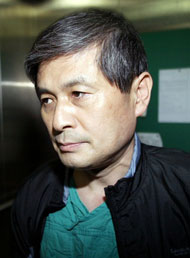
| 2005/12/17 (09:50) from 129.206.197.161' of 129.206.197.161' | Article Number : 288 |
|
|
Access : 4179 , Lines : 30 |
| Embattled Cloning Researcher Admits Problems but S |
|---|

|
|
Embattled Cloning Researcher Admits Problems but Stands by Results By Gretchen Vogel, Dennis Normile, and Constance Holden with reporting by Ji-soo Kim and Mark Russell in Seoul. ScienceNOW Daily News 16 December 2005 Admitting that his team made "human errors," cloning researcher Woo Suk Hwang has asked Science to retract his celebrated paper reporting the creation of patient specific embryonic stem (ES) cells. But in another twist in an increasingly complicated story, the researcher today rebuffed the claims of a colleague who said yesterday that Hwang had admitted falsifying data. At a packed press conference 16 December at Seoul National University, a defiant Hwang said that he and his colleagues did succeed in creating such cells, and he intends to replicate his results. Pressure on Hwang and his group has been growing as scientists and the press raised questions about the evidence presented in the paper, first published online in May this year. In 2004, Hwang and his colleagues reported the first ever success in producing a line of human embryonic stem cells from a cloned human blastocyst. In the 2005 paper, the group reported that they had established 11 ES cell lines from embryos cloned from patients, a first step toward someday making genetically matched replacement tissues. No other lab has yet replicated their results. But 2 weeks ago on a Korean Web site, an anonymous writer, who claims to be a life scientist, raised questions about some of the photographs published in the paper (ScienceNOW 6 December). A few hours later, Hwang notified Science's editorial offices of what he called mistaken duplications among the photographs of cell lines. More questions arose, however, as critics found suspicious patterns in the DNA traces that were supposed to demonstrate that the cell lines were a genetic match with the patients who had donated skin cells. Yesterday, Sung Il Roh, a fertility expert at MizMedi Hospital in Seoul, who collected oocytes from donors for Hwang's work, told Korean television and newspapers that Hwang had confessed to falsifying evidence for nine of the reported 11 cell lines. At a press conference today, Hwang acknowledged that the team had problems with their cell lines. He said that contamination had destroyed at least six of the lines the team had created. It's not clear that any of these six lines were alive at the time of submission. We were "lax in our management and committed many mistakes," Hwang said. "I apologize for causing great conflict and disappointment." But he told reporters that he was "surprised and taken aback" by Roh's statements. Reading a prepared statement, Hwang said, "I want to make it really clear that our research team produced patient specific (stem cells)." He said the team is working to thaw five remaining cell lines and will demonstrate that they are a genetic match to patient donors. Editors at Science said that in a telephone conversation with Hwang and his coauthor Gerald Schatten before Hwang's press conference, the authors said they would retract the paper. Hwang told the editors that he is still working to contact some of the two dozen coauthors, who must all agree to sign a retraction. Hwang said results from the thawed cell lines could be ready in 10 days. But either way, the results are unlikely to put the matter to rest. Observers are now questioning other papers by Hwang and his group, including the 2004 paper in Science reporting the first cloned ES cells and a report in Nature this year describing the first cloned dog (ScienceNOW 3 August). At another press briefing this afternoon in Washington, D.C., Science editor Donald Kennedy said that in their phone call, Hwang and Schatten told editors that the data in three areas--cell surface marking, DNA fingerprinting, and teratoma formation--"could not be trusted." But even though the paper contains errors that were known at the time of submission, Kennedy said there is not at present evidence to conclude scientific misconduct. Other scientists expressed dismay and confusion at the latest developments but said other labs will continue the work. "I very much hope that Hwang and his group can be given time to collect their thoughts," says Ian Wilmut, who plans to attempt to derive patient-matched stem cells in his lab at the Roslin Institute in the United Kingdom. "I am sure that they did make good steps forward and derive cell lines. I hope that they can assemble their data and present it in full because it will help the rest of us to know what can be achieved." http://sciencenow.sciencemag.org.ubproxy.ub.uni-heidelberg.de/cgi/content/full/2005/1216/1 |
|
|